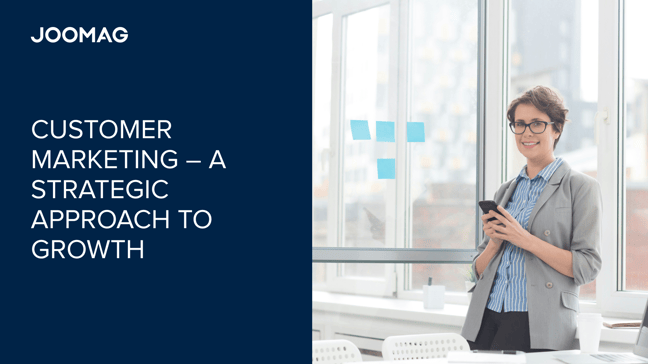Did you know that the most successful demand generation marketing campaigns begin not with flashy marketing tools or tactics, but with a deep, nuanced understanding of your customers? It might seem fundamental, yet numerous companies overlook this essential step. They become ensnared in resolving specific issues without appreciating the broader context — what genuinely excites their customers, what concerns them, and what they truly need. Venturing into demand generation campaigns without these insights is akin to navigating without a map. You might grasp the general direction of your destination, but the journey is likely to be fraught with missteps.
Key Takeaways:
In this article, we'll explore essential aspects of leveraging customer insights for demand generation strategy and your business in general:
Before proceeding you may need a refresher on Essentials of Demand Generation.
At the core of any successful marketing strategy lies a fundamental yet often overlooked principle: the power of engaging directly with your customers. Alice de Courcy, in her insightful book The Diary of a First-Time CMO, captures this essence succinctly:
“The greatest thing you can do as a marketer is talk to your customers and prospects.”
This advice is not just a reminder but a clarion call to marketers everywhere that the bedrock of all marketing efforts is the genuine connection and dialogue with the audience you aim to serve.
Echoing this sentiment, McKinsey & Company highlights the critical importance of customer insights, stating:
"A company’s ability to drive above-market growth hinges on the depth of its consumer insights and how well it translates those insights into effective action."
This perspective is not just a statement; it's a testament to the transformative power of deeply understanding your audience. By converting raw data into actionable strategies, businesses unlock a treasure trove of growth opportunities.
The significance of customer insights extends far beyond basic market research, touching every facet of your business:
-
Enhancing Acquisition and Lifetime Value (LTV): attract the perfect customers who are more likely to stick around for the long haul. That's the power of customer insights. By understanding your ideal customer profile, you can tailor your marketing efforts to resonate with their specific needs and desires. This means less wasted marketing spend and a higher customer lifetime value (LTV).
-
Minimizing Customer Acquisition Costs (CAC): Targeting the right people from the get-go means less money wasted on irrelevant marketing campaigns. Customer insights help you identify the most effective channels and strategies to reach your target audience, lowering your customer acquisition cost (CAC).
-
Bolstering Retention: Customer insights help you understand what keeps your customers happy and engaged. This allows you to develop targeted retention strategies that keep them coming back for more.
-
Streamlining Marketing Efforts: Customer insights give you the intel you need to craft targeted and relevant content that resonates with your audience. This translates to a more efficient and effective marketing strategy.
-
Fueling Product Innovation: top guessing what your customers want – ask them! Customer insights are a goldmine for product development. By understanding your audience's needs and challenges, you can identify opportunities to improve your offerings and create products that truly solve their problems.
-
Personalizing Content: People are bombarded with content every day. The only way to cut through the noise is to create content that truly resonates with your audience. Customer insights help you understand their interests and pain points, allowing you to personalize your content and deliver a superior experience.
The deeper you understand your customers, the smoother this journey becomes. But before we delve into specific tools, let's differentiate between three key concepts:
-
Customer Closeness: This is the personal connection you build with your customers. Think of it as getting to know their favorite coffee order or the challenges they face at work. You gain this closeness through direct interactions and ongoing engagement.
-
Customer Insight: This is the gold you uncover after sifting through all that valuable customer data. Insights go beyond surface-level preferences; they reveal the "why" behind customer behavior. Why do they choose you? What keeps them up at night? Insights provide a profound understanding of their needs, desires, and motivations.
-
Validation: This is the process of double-checking your assumptions. Think of it as testing a piece of treasure before celebrating – you want to be sure it's the real deal. Validation involves further research to confirm your customer insights and build a solid foundation for your marketing strategies.
-
Mine Your Existing Treasure Trove: You might be surprised by the wealth of information you already have! Start by taking an inventory of your resources:
-
analytics,
-
leads,
-
your CRM data
-
stakeholder knowledge,
-
industry news,
-
marketing data,
-
sales data,
-
customer success and customer feedback.
-
-
Identify the Missing Pieces: Once you've explored your existing resources, it's time to pinpoint any knowledge gaps.
-
how you acquire customers.
-
why do customers buy from you?
-
why do customers leave?
-
your brand perceptions?
-
market behaviors?
-
potential market size?
-
-
Invest in Dedicated Research: Think of customer research as an investment in your long-term success. Consider conducting surveys, focus groups, or even user testing to gather even deeper insights.
-
Assemble Your Dream Team: Sometimes, the best insights come from collaborating with subject matter experts. Partner with marketing gurus, sales superstars, or even industry analysts to gain a well-rounded perspective.
-
Chart Your Course: Don't embark on your research journey aimlessly. Develop a research roadmap that outlines your priorities and sets a clear timeline for ongoing investigation.
We've established that customer insights are the lifeblood of successful demand generation. But how do you tap into this valuable resource? The answer lies in asking the right questions.
The formulation and deployment of strategic questions are central to navigating the complexities of customer behavior and market dynamics. These inquiries are pivotal for extracting actionable insights that can significantly inform and enhance your sales and marketing strategies.
Here are 10 key questions to get you started:
-
Why Do Your Best Clients Choose You? This question uncovers your unique value proposition (UVP) and the differentiators that set you apart in the eyes of your most valued customers. Understanding what makes you special allows you to refine your messaging and attract more ideal clients.
-
What Are Clients Trying to Avoid? Identifying customer pain points and deal-breakers provides critical insights. What are the common challenges your customers face? What keeps them up at night? By understanding their fears and frustrations, you can tailor your offerings to address their specific needs and demonstrate how your product or service can help them avoid those pitfalls.
-
Who Are Your Real Competitors? A clear understanding of your competitive landscape goes beyond just direct competitors. Consider indirect competitors and those who might offer substitute solutions. This comprehensive view allows you to position your brand more effectively and identify potential gaps in the market.
-
How Do Potential Clients Perceive Their Greatest Challenges? Understanding the challenges faced by prospective customers can guide the development of solutions. What are the obstacles preventing them from achieving their goals? How can your product or service uniquely address these challenges?
-
What is the Real Benefit Your Company Provides? This question goes beyond features and focuses on the tangible impact your offerings deliver from the customer's perspective. What value do they perceive from using your product or service? How does it make their lives or businesses better?
-
What Trends and Challenges Are Emerging? Staying ahead of the curve is crucial. By understanding emerging market trends and challenges, you can proactively adapt your strategies and ensure your offerings remain relevant in a dynamic market.
-
How Strong is Your Brand? What Are You Known For? Evaluating your brand's strength and the attributes it embodies allows you to refine your brand image. What are you known for in the marketplace? How can you leverage those strengths and address any weaknesses in brand perception?
-
What is the Best Way to Market to Your Primary Audience? Knowing your target demographic is key. By understanding their preferred channels and how they consume information, you can optimize your marketing efforts and reach them where they are.
-
How Should You Price Your Products and Services? Understanding the price sensitivity and perceived value of your offerings is crucial for setting optimal pricing strategies. What are your customers willing to pay for what you offer?
-
How Do Your Current Clients Really Feel About You? Customer satisfaction and loyalty are key metrics. Gauging how your existing customers feel about your company provides invaluable feedback. What are you doing well? Where can you improve? By soliciting honest feedback, you can identify areas for improvement and strengthen your customer relationships.
Bridging the Gap: Aligning Your Team Around Customer Insights
Here's a scary statistic: two-thirds of employees have direct customer contact, yet they often have no idea what their customers truly care about. This disconnect hinders your ability to leverage customer insights and deliver a truly customer-centric experience.
So, how do you bridge the gap and ensure your entire team is on the same page? Here's the key:
Creating a Culture of Customer Centricity
Think of your organization as a well-oiled machine. For it to run smoothly, every cog needs to be working in sync. The same is true for customer focus. Here are some ways to achieve internal alignment:
-
Unify Your Brand Vision: Ensure everyone, from marketing to sales to product development, has a clear understanding of your brand identity, values, and how it's perceived by your target audience.
-
Demystify Customer Perceptions: Help your team see the world through your customers' eyes. Share customer feedback, case studies, and even social media sentiment analysis. This allows everyone to understand customer needs and frustrations, fostering empathy and driving more customer-centric decisions.
-
Focus on Core Challenges: What's the core problem your product or service solves? Make sure every team member understands the "why" behind your business. This ensures everyone is aligned on delivering solutions that truly address customer needs.
Fuel Innovation with Feedback: Don't hoard customer feedback! Turn it into a wellspring of innovation. Incorporate customer insights into product development roadmaps. This ensures your product continues to evolve and meet the ever-changing needs of your customers.
Unveiling Employee Perceptions
To facilitate this internal alignment, here are examples of questions that can be asked:
-
How would you best describe what we provide? This question seeks to understand employees' grasp of the company's value proposition.
-
Please describe our customers. Aiming to align employees' perceptions of the customer base with actual customer profiles.
-
What are their challenges in our sector? Encourages employees to prioritize customer challenges, aligning them with business solutions.
-
How do we benefit customers practically and emotionally? Looks at the impact of your offerings from both functional and emotional standpoints.
-
Who are our competitors? Tests employees' market awareness and understanding of the competitive landscape.
-
What is our main customer-facing message? Gauges whether internal perceptions match the brand's external communications.
-
Please list three words that best describe our brand personality. Helps assess internal alignment on brand identity.
-
What assumptions might we be making about our customers? Encourages critical thinking about potential misalignments between internal views and customer realities.
-
What would be the biggest improvement we could make for our customers? Identifies areas for product or service enhancements from an internal perspective.
Provide Access to Customer Insights for Your Employees
Regularly integrating customer insights into the fabric of your company culture is vital. This can be achieved through:-
Incorporate customer insights into all employee onboarding processes.
-
Set up weekly or monthly meetings to share customer feedback across company departments.
-
Create dedicated customer insight channels on internal communications platforms like Slack.
-
Host quarterly panels or round tables with your customers.
-
Making Net Promoter Score (NPS) a central business goal.
By aligning your team around customer insights and fostering a culture of customer centricity, you'll create a more cohesive and effective organization, ultimately driving business success. Remember, your employees are your front line. Equipping them with customer knowledge empowers them to deliver exceptional service and build stronger customer relationships. -
Refine Your Market Understanding
Knowing your Total Addressable Market (TAM) and Ideal Customer Profile (ICP) allows you to laser-focus your lead gen and demand gen efforts on the customers who matter most. This targeted approach maximizes your return on investment (ROI).
Tailored Messaging and Content
Optimize Your Marketing Channels
Align your content marketing strategies with the channels your customers frequent. Whether it's social media, email marketing, or industry publications, being present where your audience spends their time is crucial for maximizing reach and impact.
Boost Sales Team Performance
Insights: Fueling Growth Across Your Organization
Direct Product Development
Don't develop products in a vacuum. Use customer feedback to guide your product innovation efforts. By meeting evolving market demands, you'll create products that resonate with your customers, drive demand, and foster long-term loyalty.
Alignment for Success
Utilize customer insights to unify your team's goals and strategies. A cohesive approach across marketing, sales, and other departments ensures everyone is working in sync with the customer at the center.
Building a Customer-Centric Culture
Insights as the Cornerstone
Regularly share customer insights throughout your organization. This ensures all decisions are informed by the needs and preferences of your customers, ultimately leading to a more customer-centric approach.
Continuous Learning and Agility
Customer preferences and market trends are constantly evolving. Stay ahead of the curve by actively gathering and analyzing customer feedback. This allows you to adapt your strategies and remain competitive in a dynamic marketplace.
Content that Converts
Create Content that Resonates
Customer insights are the secret weapon for crafting content that resonates. By understanding your audience's needs and interests, you can create content that truly connects, fosters engagement, and builds loyalty.
Create Content Tailored to Your Audience's Preferences
People consume content in different ways. Tailor your content formats and channels to align with your audience's preferences. This makes your content more accessible and appealing, maximizing its impact.
Create Content that Guides Thourgh Customer Journey
Final Thoughts
In the landscape of demand generation, the profound understanding and application of customer insights stand as the bedrock of success. As we've navigated through the essential strategies, from deep diving into customer closeness and insight validation to the strategic application of this knowledge, it's clear that the path to impactful demand generation is through the customer's voice. The tools and techniques discussed serve not just as a guide but as a reminder of the power that lies in truly knowing and engaging with our audience.
By prioritizing these insights, businesses can forge stronger connections, tailor their offerings more effectively, and ultimately, drive growth that is both meaningful and sustainable. Remember, in the ever-evolving dialogue with your customers, your greatest asset is your willingness to listen, adapt, and innovate based on their needs and feedback.
















